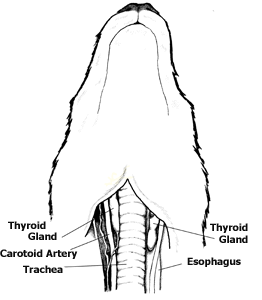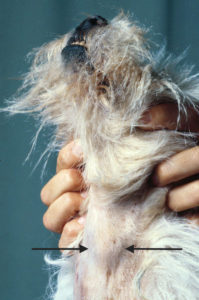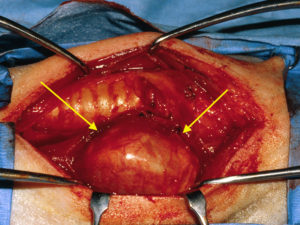
“Thyroid Tumors in Dogs – A Big Gland in the Neck”
November 21, 2016
From CriticalCareDVM
Thyroid tumors – What is the thyroid gland?
The thyroid gland is a bi-lobed organ in the neck. Found near the voice box (called the larynx), the thyroid gland produces and secretes unique hormones that help regulate the body’s metabolism. Each lobe of the thyroid gland has a plentiful blood supply, and is located near major blood vessels and nerves, including the jugular vein, carotid artery, and recurrent laryngeal nerve.


Thyroid tumors – How are they diagnosed?
There is nothing unique about finding a tumor associated with the thyroid gland. Indeed, pet parents and/or a veterinarian typically find the mass through simply palpation of the neck area either while petting or during a physical examination.
A thyroid mass can be small or large, and may or may not be moveable with manipulation. Depending on the size of the mass, some dogs may have difficulty swallowing and/or may have an altered bark. Tumors generally develop in older patients, and males and females are affected equally. Some breeds – Boxers, Beagles, and Golden Retrievers – are reportedly over-represented for developing thyroid cancer.

A dog with a thyroid mass.
Thyroid tumors – What testing is needed?
Sampling of the thyroid mass is needed to obtain a definitive diagnosis. Given the proximity of the thyroid gland to important blood vessels, advanced imaging – sonography, computed tomography (CT scan), or magnetic resonance imaging (MRI) – is strongly recommended. Ideally the thyroid mass should be completely removed and submitted for biopsy. However, this isn’t always possible. When complete removal isn’t feasible, the veterinarian will remove as much as is safe to obtain a definitive diagnosis. Surgical removal of the thyroid gland can be quite intricate, and partnering with a board-certified veterinary surgeon can be instrumental in avoiding complications.
A less invasive sampling modality is called a fine needle aspiration. During this procedure, a vaccine-sized needle is used to aspirate cells from the thyroid gland. The cells are then evaluated by a board-certified veterinary clinical pathologist. Unfortunately, this test is only accurate and diagnostic 50% of the time, and has potential serious complications like severe bleeding. Overall, almost 90% of thyroid masses in dogs are cancerous/malignant.
After detecting a thyroid mass, a veterinarian will also recommend performing some additional tests, including:
· Complete blood count – a non-invasive blood test that provides information about red blood cells, white blood cells, and platelets
· Biochemical profile – a non-invasive blood test that helps evaluate liver and kidney function, as well as electrolytes (i.e.: sodium, potassium, etc.) and gastrointestinal enzymes
· Urinalysis – a non-invasive urine test to help assess kidney function, and to evaluate for possible inflammation and/or infection
· Thyroid hormone levels – a simple blood test to determine if the thyroid mass is excreting excessive amounts of thyroid hormones. Approximately 20% of dogs with thyroid carcinoma secrete too much thyroid hormones.
· Coagulation testing – a simple blood test that helps to determine if a pet can form a proper blood clot
Thyroid tumors – How can I tell if they have spread?
Approximately 25% of dogs with thyroid cancer have tumor metastasis at the time of diagnosis. Larger tumors spread more often than smaller ones, and spread is most commonly to local lymph nodes and the lungs. Veterinarians can perform some minimally invasive diagnostic imaging to help determine if a thyroid tumor has spread. These tests including:
· Chest radiographs/x-rays – these images help identify metastasis to the lungs
· Regional lymph node cytology – a minimally invasive procedure to determine if the thyroid cancer has spread to the local lymph nodes
· Scintigraphy – a patient is injected intravenously with a safe amount of radioactive material called pertechnetate. This chemical reveals areas of thyroid tissue in a variety of inappropriate areas if a tumor has spread. This technology is traditionally only available at referral/specialty veterinary hospital.
Thyroid tumors – How are they treated?
The ideal therapy for thyroid tumors that are freely moveable with no evidence of metastasis is surgical removal. In such patients, the reported median survival time has been reported to be 20.5 months. In patients for whom complete surgical removal is not feasible, treatment with radiation therapy can be effective. Median survival time with radiation therapy has been reported to be 24.5 months, and potential self-limiting side effects are hoarse voice, cough and difficulty swallowing. Therapy with radioiodine is also possible for dogs with thyroid cancer. The radioactive iodine travels to any area of metastasis, and thus can be effective in those patients with tumor spread. Median survival time has been reported to be 30 months. Both radiation and radioiodine therapies are performed under the direction of board-certified veterinary cancer specialists at referral/specialty veterinary hospitals. The efficacy of chemotherapy for the treatment of thyroid cancers in dogs is currently questionable.

The yellow arrows highlight a thyroid tumor in a dog.
The take-away message about thyroid tumors in dogs
The thyroid gland is instrumental for regulating a dog’s metabolic rate. Unfortunately, masses of this hormone-producing organ can develop, and the vast majority of them are cancerous. Early identification and treatment are key for maximizing the likelihood of a positive outcome. Partnering with board-certified veterinary surgeons and cancer specialists is strongly recommended.
To find a board-certified veterinary cancer specialist, please visit the American College of Veterinary Medicine.
To find a board-certified veterinary surgeon, please visit the American College of Veterinary Surgeons.
Additional Information from Veterinary Cancer
Thyroid tumors are relatively uncommon in dogs, accounting for 1.2%-3.8% of all canine tumors. Up to 50% of thyroid tumors in dogs are benign adenomas. Most of these benign adenomas are not clinically detectable. Therefore, when a mass is palpated in a dog in the thyroid area, the majority are actually malignant tumors. The cause of thyroid carcinoma is unknown, however thyroid-stimulating hormone (TSH) may play a role. Thyroid irradiation is associated with an increased incidence of thyroid tumors in all species, including humans and dogs.
Can my pet still be treated if the disease is advanced or metastasis has already occurred?
In patients whose tumors are causing significant compression on the structures of the throat or causing significant compromise to quality of life, definitive therapy is not encouraged. However, the progression of metastatic disease in the lungs tends to be relatively slow in comparison with other tumor types. We have treated patients with lung metastasis with intermittent maximum dose chemotherapy as well as metronomic therapy that have survived over 2 years following the detection of spread of the cancer. Decisions to treat at these stages are made on an individual basis with emphasis on quality of life issues.








